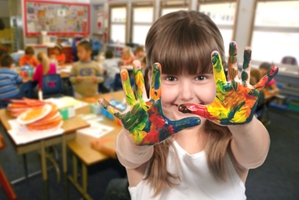One of the expectations the Common Core State Standards have of teachers and students is that they find ways to relate English/language arts and mathematics subject matter to the real world. In mathematics, this is called "modeling." According to the Common Core, modeling is a tool students can use to connect "classroom mathematics and statistics to everyday life, work, and decision-making." And one of the best ways to teach modeling is to take mathematics outside of the classroom, and incorporate it into other subjects and lessons - including arts classes. Here are three specific ways arts classes can help students connect math to non-mathematics situations:
1. Teaching geometry with visual art
Many schools offer visual art electives, such as painting and drawing, and the instructors of these classes have the perfect opportunity to teach students another way to think about geometry. Even kindergartners and other younger students can learn shapes better by incorporating them into pictures in art class (i.e., a triangle and a square connected can make a house, while a long rectangle and a circle could be a tree). As students grow into middle and high school, art instructors can ask them to design art that meets certain criteria. For example, a painting may need to somehow incorporate three circles, each with a radius 1.5 times the length of the last.
2. Teaching counting with music
Because music is a set of rhythms and patterns, it's inherently connected to math in many ways. So, music teachers of younger students can ask them to count how many beats are in a single measure of a song or distinguish a certain pattern of beats. There are also specific songs and musical activities that can teach younger children about counting, addition and subtraction (such as Five Little Monkeys Jumping on the Bed). Older students can benefit from learning about time signatures (which are also a great way to learn about fractions) and how they affect the music when altered slightly.
3. Teaching fractions with drama
Drama classes are a fun way for students to model fractions, because they provide a visual way for students to understand the concept. Teachhub.com offers an interesting activity called "Fraction Mime" in which students must create fractions as a group without speaking to each other. For instance the teacher may ask them to divide into 1/4 or 3/8 of the whole group. Drama teachers can even ask students to keep track of how many of their classmates are participating in a single scene at once. If the scene calls for 4 students, out of a total of 16 in the class, how many ways can students show that using fractions?


